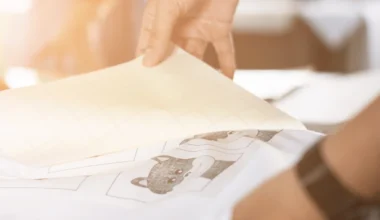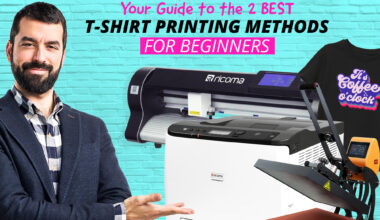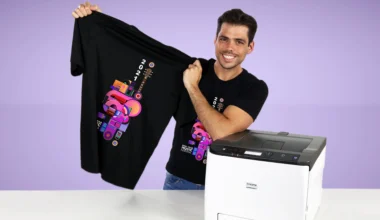Are you looking to tap into the creative and profitable world of custom mug making? Whether you’re an artist, entrepreneur, or simply someone with a passion for personalized gifts, learning how to make custom mugs to sell can be an exciting and rewarding venture.
Let’s walk you through how to make custom mugs to sell, whether to complement an existing business or start a new one altogether!

How to Make Custom Mugs to Sell
Pick the Mug Style You Want
The first step in creating custom mugs is choosing the right mug style that resonates with your target audience. The type of mug you select will set the tone for your designs and influence the overall appeal of your products. Here are some considerations to keep in mind:
Think about who you’re designing for. Are they coffee enthusiasts who might prefer a sturdy ceramic mug, or are they on-the-go individuals who would appreciate a durable stainless steel travel mug? Do you have an existing audience from your brand or social media channels, or are you looking to create an Etsy or Shopify store and create a bunch of different patterns?
Different materials come with varying levels of durability and cost.
Ceramic mugs are classic and widely popular, but they can be fragile.
Glass mugs offer a sleek and modern look, but they’re also prone to breaking.
Stainless steel mugs are robust and great for travel, but they might be more expensive to produce.
We offer ceramic, glass, and even color-changing mugs safe for sublimation so you can make sure your design will live happily on your mug for years to come.
Make Your Mug Design
Creating a unique and appealing design is crucial for your custom mug business to stand out in the market.
Your design not only reflects your brand but also attracts potential customers.
In a sea of generic mugs, a distinctive design can set your product apart. Think about what makes your style different and how you can incorporate that into your custom diner mugs. Is it a brand with a distinct logo, slogan, or phrase? Maybe a signature color palette, symbol, or illustration? Or are you making a custom pet mug with a custom message for a more personalized effect?
If you want to start super DIY, you can explore hand-painting, which offers a personal touch and artisanal feel. However, it’s time-consuming and might not be suitable for large orders and when you start to scale your mug creation.

Here are some more creative ideas for putting your brand on a mug:
- Sketch out your design on paper using pencils, markers, or paint. Once you’re satisfied with the design, scan it or take a high-quality photo to digitize it.
- Use graphic design software such as Adobe Photoshop, Illustrator, or free alternatives like GIMP or Inkscape to create your design digitally. These tools offer a wide range of tools and effects to enhance your design.
- Experiment with different fonts and text arrangements to create a typography-based design. You can combine different fonts, sizes, and colors to make your custom text mug stand out.
- If you have strong hand-lettering skills, you can create a design using various lettering styles. Practice on paper first and then transfer your design to a digital format if needed.
- Create your design using vector graphics, which allow you to scale the design to any size without losing quality. Software like Adobe Illustrator is ideal for creating vector-based designs.
Print Your Mug
This is where things can get interesting— figuring out how to go from idea to implementation, right on the mug.
There are a whole lot of different printing techniques that offer various results in quality, durability, and cost.
If you’re just starting, you’re probably looking into platforms that print your mugs for you like VistaPrint or RedBubble, which is a great way to start if you’re just getting started in mug-printing. It’s a great way to start your business, but eventually, you might find that the fees they’re collecting per order outweigh what you could be making on your own.
There are a few different printing methods—
- Sublimation printing: This method uses heat to transfer dye onto the mug, resulting in vibrant and long-lasting colors. It’s ideal for detailed designs and photographs. Note that sublimation printing requires a special coating on mugs, so make sure to purchase the proper, sublimation-friendly mugs.
- Heat transfer vinyl: This uses heat and pressure to transfer a vinyl design by using a cutting machine, weeding out the excess vinyl, and pressing the design onto a mug.
- 2-Step heat transfer: 2-Step heat transfer involves printing the design onto a special paper and then transferring it to the mug using heat and pressure. It’s versatile and works well for both simple and complex designs. The durability can vary depending on the quality of the transfer paper and ink used.
When choosing the right printing method, consider the complexity of your design, the durability you need, and your budget. Each technique has its advantages and disadvantages, so select the one that best aligns with your business goals and production capabilities.
Find Your Distribution Platform
Once your custom mugs are ready, it’s time to choose the right platform to sell them. Each platform has its own set of advantages and disadvantages, so consider your target audience and business goals when making your decision.
- Online marketplaces (Etsy, Amazon): These platforms offer a wide reach and can connect you with a large audience of potential buyers. They handle the transaction process and provide a level of trust for customers. However, they also take a percentage of your sales as fees, and you’ll be competing with many other sellers.
- Your own website: Selling on your own website gives you complete control over your brand, pricing, and customer experience. You can create a personalized shopping experience and build a direct relationship with your customers. But it takes money and time to get traffic to your website— from investing in website design, e-commerce functionality, and marketing to drive traffic to your site.
- Local craft fairs: Participating in local craft fairs allows you to connect with customers face-to-face and build a local following. It’s a great way to showcase the quality of your mugs and get immediate feedback. But this is for those who have the time and energy to set up booths and who understand that their sales are limited only to the duration of the fair.
Custom Mugs: Frequently Asked Questions
Can I Use Any Type of Mug for Customizing?
When it comes to customizing mugs, the type of mug you choose is crucial for achieving the desired outcome.
Not all mugs are suitable for every printing technique. For example, sublimation printing requires mugs with a special polymer coating, while screen printing works best on smooth, flat surfaces.
The material of the mug can affect the customization process and the final result. Ceramic mugs are versatile and widely used for various printing methods. Glass mugs offer a sleek look but may require specific types of ink or decals. Metal mugs, such as stainless steel, are great for durability but might be limited to certain types of customization like laser engraving.

What Materials Do I Need to Make Custom Mugs?
If you’re just starting your mug-making business and are starting on a platform that has your mugs for you, all you need is some creativity, time, and energy to get your mug business started!
Once you’ve spent some time selling mugs and want to scale your earnings, here’s some top-notch equipment you’ll want to invest in:
- Blank mugs: Choose high-quality mugs that are suitable for the printing technique you plan to use. Ensure they are clean and free from any defects.
- Printing equipment: Depending on your chosen method, you may need a transfer printer, vinyl cutter, or a heat press for transferring designs.
- Design software: Software like Adobe Illustrator or Photoshop is essential for creating and editing your mug designs.
- Transfer paper: For techniques like 2-step heat transfer printing, you’ll need special transfer paper or transfer film that can withstand high temperatures and transfer the design onto the mug.
Learning how to make custom mugs to sell doesn’t need to cost an arm and a leg, but once you start seeing a return from your mugs, you can look into quality, long-lasting products that’ll make your printing journey that much easier and more scalable.
How Should I Price My Mugs?
Calculate the cost of materials, printing, and labor to determine your base cost. Once you’ve started investing in your own mug-printing materials, include overhead expenses like equipment maintenance and utilities.
You’ll also want to research the market to understand what customers are willing to pay for custom mugs. Look at similar products and see how they are priced. Analyze your competitors’ pricing strategies. You don’t want to price too high and drive customers away or too low and undercut your profit margin.
Decide on a profit margin that allows you to be competitive while ensuring a sustainable business. A typical markup for retail products is around 50-100%.
Ultimately, knowing how to make custom coffee mugs to sell means knowing the between profitability and affordability. Don’t undervalue your work, but also be mindful of what the market can bear!
Scale Your Mug-Making Business With Ricoma
Know how to make custom mugs to sell, expand your product line, increase your production capacity, and scale your mug-making business with Ricoma! With a range of high-quality printing equipment and expert support, Ricoma can provide the tools and guidance you need to scale your operations and help your business thrive!






